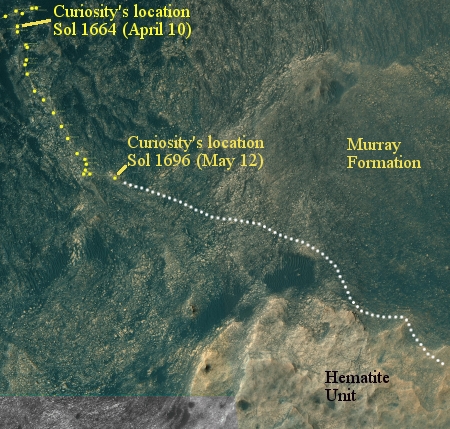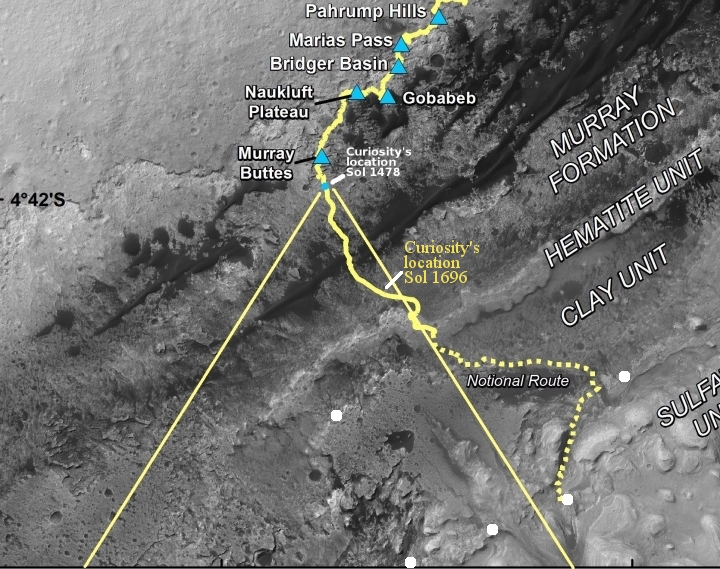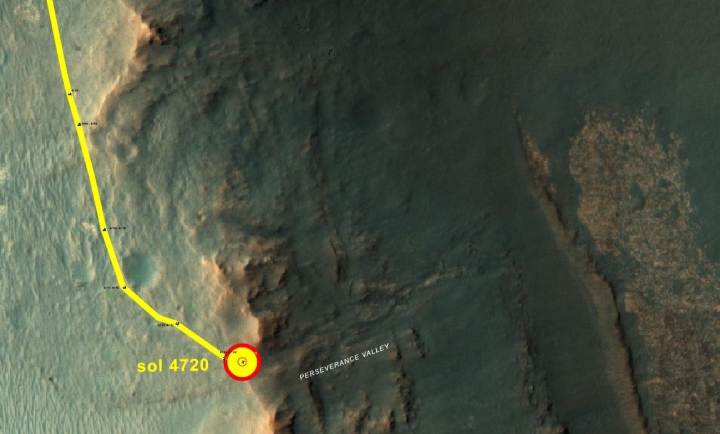Mars rover update: May 15, 2017
This update could also be entitled, “Up and down into Martian gullies,” as that is what both rovers, Curiosity and Opportunity, are presently focused on doing.
Curiosity

For the overall context of Curiosity’s travels, see Pinpointing Curiosity’s location in Gale Crater.
In the past month, since my previous April 21, 2017 update, Curiosity has been working its way up the dry wash, frequently stopping to inspect the rocky surface terrain within. As they note,
As we climb up Mount Sharp, recently over slopes of 4-6 degrees, we have seen more varied outcrop structures and chemistries than the rest of the Murray formation, and such changes catch the collective eye of the team.
Only in the last week have they shifted to the east, as planned. Their near term goal is the lighter, yellowish layer of rock, dubbed the Hematite Unit, that sits higher up the slope of Mount Sharp. As they have been traveling on the Murray Formation now for more than a year, since March, 2016, I am certain the science team is even more eager to get to this different layer of geology to find out what it is made of and why it is there.
You can get an overall view of the geology Curiosity is traversing from this October 3, 2016 press release. Below is a version of the traverse map shown at that site that I posted as part of my October 6, 2016 rover update, updated to show Curiosity’s present location. It is apparent that Curiosity is finally moving out of the foothills below Mount Sharp and beginning its climb up the mountain’s actual slopes.

Opportunity
For the overall context of Opportunity’s travels at Endeavour Crater, see Opportunity’s future travels on Mars.
Since my April 21, 2017 update, Opportunity has raced quickly along the rim of Endeavour Crater, reaching the head of Perseverance Valley, the gully that they have been aiming for since leaving the interior of the crater’s rim in February.
Even as I was preparing this update, the Opportunity science team released a new press release that essentially sums up what I was going to write.
The process that carved Perseverance Valley into the rim of Endeavour Crater billions of years ago has not yet been identified. Among the possibilities: It might have been flowing water, or might have been a debris flow in which a small amount of water lubricated a turbulent mix of mud and boulders, or might have been an even drier process, such as wind erosion. The mission’s main objective with Opportunity at this site is to assess which possibility is best supported by the evidence still in place.
The upper end of the valley is at a broad notch in the crest of the crater rim. The rover team’s plan for investigating the area begins with taking sets of images of the valley from two widely separated points at that dip in the rim. This long-baseline stereo imaging will provide information for extraordinarily detailed three-dimensional analysis of the terrain. The valley extends down from the rim’s crest line into the crater, at a slope of about 15 to 17 degrees for a distance of about two football fields. “The long-baseline stereo imaging will be used to generate a digital elevation map that will help the team carefully evaluate possible driving routes down the valley before starting the descent,” said Opportunity Project Manager John Callas of JPL.
Reversing course back uphill when partway down could be difficult, so finding a path with minimum obstacles will be important for driving Opportunity through the whole valley. Researchers intend to use the rover to examine textures and compositions at the top, throughout the length and at the bottom, as part of investigating the valley’s history.
Below is the traverse map from this release, reduced and cropped to show here.

On Christmas Eve 1968 three Americans became the first humans to visit another world. What they did to celebrate was unexpected and profound, and will be remembered throughout all human history. Genesis: the Story of Apollo 8, Robert Zimmerman's classic history of humanity's first journey to another world, tells that story, and it is now available as both an ebook and an audiobook, both with a foreword by Valerie Anders and a new introduction by Robert Zimmerman.
The print edition can be purchased at Amazon or from any other book seller. If you want an autographed copy the price is $60 for the hardback and $45 for the paperback, plus $8 shipping for each. Go here for purchasing details. The ebook is available everywhere for $5.99 (before discount) at amazon, or direct from my ebook publisher, ebookit. If you buy it from ebookit you don't support the big tech companies and the author gets a bigger cut much sooner.
The audiobook is also available at all these vendors, and is also free with a 30-day trial membership to Audible.
"Not simply about one mission, [Genesis] is also the history of America's quest for the moon... Zimmerman has done a masterful job of tying disparate events together into a solid account of one of America's greatest human triumphs."--San Antonio Express-News


The rovers are doing great, but it’s time to move beyond rovers… or at least give them and more like them local controllers.
I’m ready to buy stock in the local mars stock exchange. Can hardly wait to see what new companies are formed there. What will be the first?
Rovers operate on such little power. Long shot guess for first company? Charging stations for the new Tesla model T exploration and taxi rovers.
ken anthony
“The rovers are doing great, but it’s time to move beyond rovers…”
It is happening, yeay! It’s even law that this thing must fly on Mars 2020. And incredibly it works fine in the lab. I wouldn’t’ve bet a dime on it but here we are. Great for Mars exploration. Can land where no rover can go, for example on those seasonal dark strikes along steep hill sides which might be subsurface streams of liquid water (where the ALIENS live, you know!)
https://www.youtube.com/watch?v=w3y7iJEe7uM
A helicopter scout is cool, but better would be a simple helium balloon tethered to a rover. You wouldn’t be power limited to a few minutes of operation. It would operate continuously and always be where it needs to be by virtue of being tethered to the rover. It’s also much easier to deploy.
But I was referring to people on site tele-operating or in a mars buggy.
I guess a balloon would have to be about 100 times larger on Mars than on Earth. The air it displaces has only about 1% the density of air on Earth’s sea level. I’m not sure such a balloon could lift itself even without any payload. Not until 1865 was a lab vacuum created that was as thin as Mars’ atmosphere where and when it is the thickest. I’m surprised they make the chopper fly, but so it does. A prototype has been tested successfully in simulated Mars atmosphere. It is quite power intensive and will charge all day to make one jump.